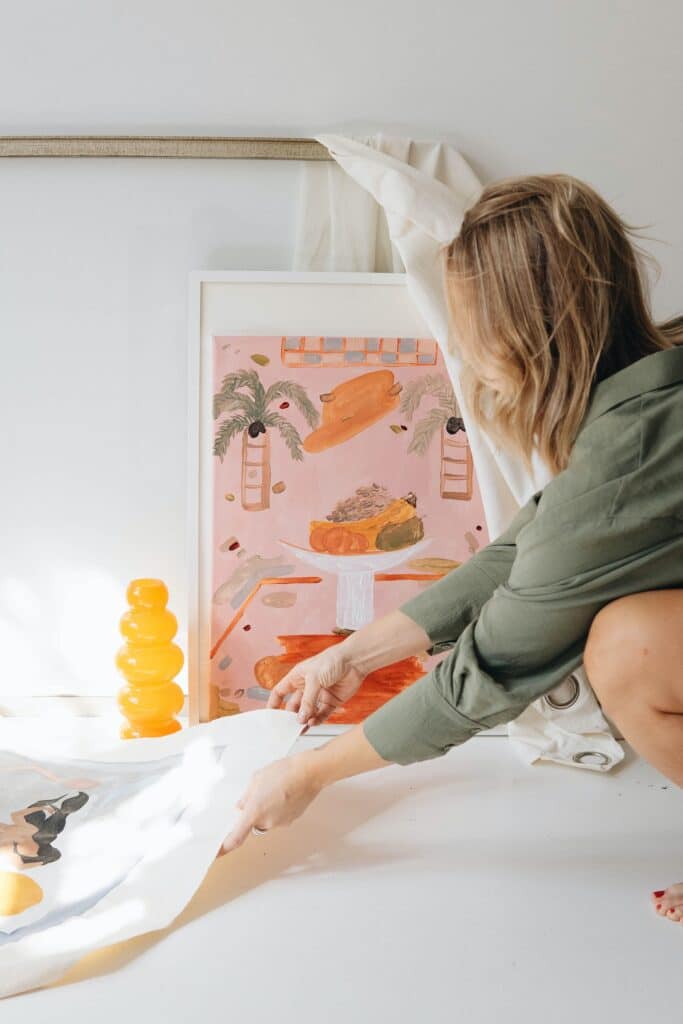Se você nunca tentou se instalar em um mercado de arte local e vender seu trabalho, pode estar perdendo uma ótima maneira de obter uma renda suplementar com seu trabalho criativo, além de fazer novos contatos e divulgar sua marca.
Antes de prosseguirmos, é importante observar que nem todo mercado de arte será adequado para o seu trabalho - e tudo bem! Há um mercado de arte para cada nicho, comunidade e feriado, portanto, é mais importante dedicar tempo para descobrir quais mercados de arte são adequados para você em vez de se lançar no primeiro grande mercado que encontrar. Como existem tantos, pode ser difícil restringir a lista, portanto, talvez você queira se concentrar em algumas considerações importantes.
Escolhendo suas impressões
A quantidade de trabalhos que você traz e as impressões que escolhe dependerão do mercado em que você participa. Em geral, você provavelmente não levará impressões de todas as obras de arte do seu portfólio. Em vez disso, você desejará personalizar suas impressões para obter o melhor retorno do seu investimento.
Compreender seu público-alvo
Dependendo do mercado de arte do qual participa, você provavelmente levará um conjunto personalizado de impressões com base nas pessoas que provavelmente estarão presentes. Por exemplo, se você estiver participando de um mercado de férias, talvez queira levar impressões com temas de férias ou impressões de qualidade superior com embalagens atraentes que seriam bons presentes de férias. Se você estiver participando de um mercado de arte do orgulho, as impressões com um foco mais inclusivo e queer serão bem aceitas.
Nem todos os tipos de trabalho vendem bem em todos os tipos de mercado, portanto, tenha em mente quem está participando - você provavelmente não gostaria de aparecer em uma convenção de quadrinhos vendendo trabalhos sobre a natureza ou em um mercado de arte de centro comunitário vendendo boudoir.
A qualidade e a apresentação são importantes
Alguns mercados exigirão impressões de maior qualidade do que outros, enquanto outros exigirão que você se preocupe mais com a apresentação do seu trabalho. Dependendo do tipo de mercado que você frequenta, pode ser mais ou menos necessário concentrar-se na qualidade de suas impressões.
Como regra geral, se estiver vendendo em um mercado que valoriza edições limitadas, qualidade de galeria ou trabalhos únicos, você deverá imprimir seu trabalho profissionalmente em materiais de alta qualidade ou até mesmo vender criações originais. Também pode ser necessário emoldurar e assinar seu trabalho e ter uma embalagem adequada à mão para evitar danos à impressão.
Se você estiver vendendo em um mercado que enfatiza o alto volume de compras - pense em convenções de quadrinhos, mercados de orgulho e pequenos mercados administrados por artistas -, você desejará gastar menos com a qualidade geral do material do seu trabalho. A impressão em lote e as capas de plástico serão mais comuns aqui, juntamente com tamanhos de impressão menores, e a moldura será muito menos comum. Você desejará ter um volume maior de impressões de baixo a médio custo, em vez de edições limitadas muito caras.
Como você define o preço de suas impressões
O preço pode ser um ponto de atrito para muitos criativos, bem como para clientes em potencial. Determinar o equilíbrio correto entre acessibilidade e lucratividade dependerá do tipo de impressão que você está vendendo e do mercado em que está participando.
Para começar, considere o custo total necessário para criar suas impressões. Considere o custo da impressão, da embalagem, o tempo que você levou para fazer a impressão, qualquer material promocional que você embalará com ela e os custos indiretos associados à participação no mercado. Determinar esses custos pode ser um ótimo ponto de partida para a determinação de preços e pode ajudar você a evitar cair na armadilha de subestimar e subvalorizar o seu trabalho.
Além desses custos, você deve considerar os tipos de trabalho que serão vendidos por outros artistas no mercado em que você está participando. As impressões pequenas são mais populares do que as grandes? O mercado favorece trabalhos mais caros e únicos? Os descontos por quantidade são comuns? Embora o seu nível de habilidade e os custos indiretos sejam um fator importante, as taxas de venda regulares de outros artistas também são importantes.
Para ajudar na pesquisa, você pode considerar a possibilidade de participar de alguns mercados de arte locais antes de definir o preço. Isso garantirá que você esteja mais preparado quando chegar a hora de participar do seu próprio mercado.

No mercado de arte
Então você já definiu seu preço, sabe quanto trabalho deve levar e está chegando às etapas finais de preparação. Mas agora vem a parte mais difícil: descobrir como você se apresentará e se promoverá no mercado de arte.
Marketing e promoção
Fazer a venda é apenas metade do trabalho necessário para uma exposição bem-sucedida no mercado. A maioria das pessoas que visitam seu estande provavelmente irá embora sem comprar. Em um mercado com muitos estandes, os clientes em potencial podem ser exigentes com seu dinheiro. Isso pode ser desencorajador para um vendedor de primeira viagem, mas é importante reconhecer que muitos visitantes de mercados de arte vêm para ver os produtos com a intenção de comprá-los posteriormente.
Por esse motivo, você deverá ter algum tipo de material promocional com você. Você pode considerar o seguinte:
- Cartões de visita
- Cupons
- Cartões postais e marcadores de página
- Adesivos
Os itens acima são todos pequenos e relativamente baratos para serem produzidos em massa. Todos esses itens devem conter sua mídia social ou seu website e ajudarão os clientes em potencial a encontrar você no mercado.
Como você está montando seu estande
Depois de chegar ao mercado, você deve ter um plano claro de como montará seu estande, levando em conta aspectos como localização, estandes de exposição e como lidará com as transações.
Localização do estande
Na maioria dos mercados, você terá duas opções principais em relação ao tipo e ao local do estande: estandes de canto e estandes comuns. A maioria dos estandes comuns em mercados e convenções consiste em uma mesa de 1,80 m de comprimento e cadeiras. Uma saia de mesa simples pode ou não ser incluída em seu estande.
Os estandes de canto podem ser um pouco mais diversificados. Eles podem incluir duas mesas de 2,5 metros de comprimento ou podem incluir apenas espaço no chão, com a intenção de permitir que você configure o espaço para ser mais interativo. Os estandes de canto também são considerados locais privilegiados porque têm maior probabilidade de atrair clientes, portanto, lembre-se de que o preço refletirá isso.
Expositores
A verticalidade é importante e frequentemente negligenciada pelos vendedores iniciantes. É mais provável que os vendedores ao redor de você tenham algum tipo de estrutura vertical para fixar seus trabalhos. Se você aparecer sem estruturas semelhantes, seu estande poderá ser ignorado pelos possíveis compradores.
Quando você está começando nos mercados de arte, provavelmente não precisará de nada sofisticado. Os cubos de armazenamento de arame consistem em quadrados de arame com grades que se encaixam para formar cubos. Eles são ótimos para exposições em feiras porque são leves, mas resistentes, e podem ser montados em configurações personalizadas. Você pode pendurar impressões, marcadores de página, materiais promocionais e outros itens pequenos nos cubos de armazenamento de arame. Eles também são fáceis de decorar!
Manuseio de transações
Depois de fazer todo o trabalho tedioso de montar seu estande, lidar com as transações é uma etapa mais fácil. Você deve certificar-se de que tem uma maneira fácil de registrar as transações, troco suficiente para processar compras em dinheiro e uma maneira de aceitar cartões de crédito. Para isso, você pode procurar um serviço de processamento de transações como o Square ou o Stripe.
Envolvimento com os clientes
Ao interagir com os clientes, é importante lembrar que você deve ser amigável e prestativo, mas não em excesso. A maioria dos visitantes dos mercados de arte está lá para ver as obras e a última coisa que você quer fazer é assustar os compradores em potencial com vendas excessivas.
Ao trabalhar em um mercado de arte, uma boa regra geral a ser seguida é cumprimentar, apresentar-se e informar aos possíveis compradores que você está lá para ajudá-los caso tenham alguma dúvida. Se você perceber que os compradores em potencial demoram ou olham fixamente para um produto específico, você pode intervir para oferecer mais informações.
Outro aspecto importante a ser considerado é a narração de histórias como parte de suas interações com os possíveis compradores. Se um comprador em potencial estiver vendo uma peça por um período de tempo significativo ou se ele pedir mais informações, essa é a sua oportunidade de compartilhar um pouco da sua visão como artista e do seu processo criativo. Isso pode gerar mais interesse e investimento em seu trabalho.
Quando os compradores e possíveis compradores estiverem saindo do seu estande, você poderá ser proativo e oferecer um cartão de visita ou outro material promocional. Essa é uma ótima maneira de gerenciar a retenção de clientes e criar relacionamentos duradouros.

Após o mercado
A feira acabou, você desmontou seus expositores, empacotou suas coisas e levou tudo para casa. A essa altura, você provavelmente está exausto e pronto para dormir até amanhã. E quando você tiver feito isso, talvez seja uma boa ideia analisar como foi a feira.
Os mercados de arte são uma experiência de aprendizado. Poucas pessoas farão um excelente trabalho na primeira vez, mas todos aprenderão algo com isso. Esperamos que, depois do seu primeiro mercado de arte, você tenha aprendido bastante sobre o que funcionou e o que não funcionou, e como melhorar para a próxima vez.
A primeira coisa que você deve analisar são as vendas e as despesas. É importante analisar objetivamente o desempenho geral que você teve, inclusive a eficácia de seus preços e o volume de produtos vendidos. Isso pode ser assustador, mas é uma etapa necessária para determinar como você pode melhorar.
Depois de analisar suas vendas e calcular o lucro líquido que você obteve durante o mercado de arte, é uma boa ideia verificar e considerar como as coisas corresponderam às suas expectativas. Você preparou as coisas certas? Houve algo que você deixou passar? Algumas coisas funcionaram de forma diferente do que você esperava? Talvez uma determinada peça tenha vendido muito bem, enquanto outra que você esperava que vendesse bem não vendeu bem.
Seja qual for o caso, analisar suas vendas de uma perspectiva analítica e crítica fornecerá a você o conhecimento necessário para se preparar de forma mais eficaz na próxima vez.
Os mercados de arte podem ser uma experiência impressionante. No final, eles também podem ser uma ótima maneira de comercializar seus negócios, fazer contatos com a comunidade criativa e gerar renda em um curto espaço de tempo.
Lembre-se, sua primeira tentativa nunca será perfeita! Mas esperamos que, seja qual for o tipo de mercado que você escolher participar, você tenha um pouco mais de conhecimento agora para saber que tipos de coisas deve considerar.












